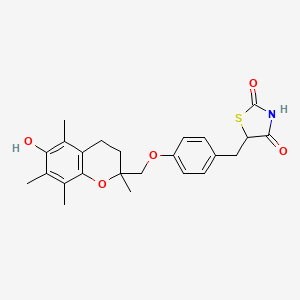
Troglitazone
Numéro de catalogue B1681588
Poids moléculaire: 441.5 g/mol
Clé InChI: GXPHKUHSUJUWKP-UHFFFAOYSA-N
Attention: Uniquement pour un usage de recherche. Non destiné à un usage humain ou vétérinaire.
Patent
US05700820
Procedure details


15.5 g of 5-[4-(6-hydroxy-2,5,7,8-tetramethyl chroman-2-yl-methoxy) benzyl]-2-iminothiazolidine-4-one, prepared by the process as described in Example-1, was added to a mixture of 225 ml of acetic acid, 75 ml of conc. hydrochloric acid and 40 ml of water and the mixture was refluxed for 12 hrs. The reaction mixture was cooled to room temperature and 66.2 g of sodium bicarbonate was added and once the evolution of carbondioxide had ceased, the solvent was distilled off applying high vacuum. A 10:1 by volume mixture of benzene and ethyl acetate was added to the residue and the crude product was washed with a mixture of equal volumes of a saturated aq. sodium bicarbonate solution & water. The organic layer was dried over anhydrous sodium sulphate and the solvent was distilled off. The resulting crude product was quickly eluted from a silica gel column with 50% ethylacetate-hexane to furnish 12.5 g of the required 5-{4-(6-hydroxy-2, 5, 7, 8-tetramethylchroman-2-yl-methoxy) benzyl) thiazolidine-2,4-dione (Troglitazone) with a HPLC purity of ~67-70%.
Name
5-[4-(6-hydroxy-2,5,7,8-tetramethyl chroman-2-yl-methoxy) benzyl]-2-iminothiazolidine-4-one
Quantity
15.5 g
Type
reactant
Reaction Step One





Identifiers


|
REACTION_CXSMILES
|
[OH:1][C:2]1[C:3]([CH3:31])=[C:4]2[C:9](=[C:10]([CH3:13])[C:11]=1[CH3:12])[O:8][C:7]([CH2:15][O:16][C:17]1[CH:30]=[CH:29][C:20]([CH2:21][CH:22]3[S:26][C:25](=N)[NH:24][C:23]3=[O:28])=[CH:19][CH:18]=1)([CH3:14])[CH2:6][CH2:5]2.C(O)(=[O:34])C.Cl.C(=O)(O)[O-].[Na+]>O>[OH:1][C:2]1[C:3]([CH3:31])=[C:4]2[C:9](=[C:10]([CH3:13])[C:11]=1[CH3:12])[O:8][C:7]([CH2:15][O:16][C:17]1[CH:30]=[CH:29][C:20]([CH2:21][CH:22]3[S:26][C:25](=[O:34])[NH:24][C:23]3=[O:28])=[CH:19][CH:18]=1)([CH3:14])[CH2:6][CH2:5]2 |f:3.4|
|
Inputs


Step One
|
Name
|
5-[4-(6-hydroxy-2,5,7,8-tetramethyl chroman-2-yl-methoxy) benzyl]-2-iminothiazolidine-4-one
|
|
Quantity
|
15.5 g
|
|
Type
|
reactant
|
|
Smiles
|
OC=1C(=C2CCC(OC2=C(C1C)C)(C)COC1=CC=C(CC2C(NC(S2)=N)=O)C=C1)C
|
Step Two
|
Name
|
|
|
Quantity
|
225 mL
|
|
Type
|
reactant
|
|
Smiles
|
C(C)(=O)O
|
|
Name
|
|
|
Quantity
|
75 mL
|
|
Type
|
reactant
|
|
Smiles
|
Cl
|
|
Name
|
|
|
Quantity
|
40 mL
|
|
Type
|
solvent
|
|
Smiles
|
O
|
Step Three
|
Name
|
|
|
Quantity
|
66.2 g
|
|
Type
|
reactant
|
|
Smiles
|
C([O-])(O)=O.[Na+]
|
Conditions


Temperature
|
Control Type
|
AMBIENT
|
Other
|
Conditions are dynamic
|
1
|
|
Details
|
See reaction.notes.procedure_details.
|
Workups


TEMPERATURE
|
Type
|
TEMPERATURE
|
|
Details
|
the mixture was refluxed for 12 hrs
|
|
Duration
|
12 h
|
DISTILLATION
|
Type
|
DISTILLATION
|
|
Details
|
the solvent was distilled off
|
ADDITION
|
Type
|
ADDITION
|
|
Details
|
A 10:1 by volume mixture of benzene and ethyl acetate
|
ADDITION
|
Type
|
ADDITION
|
|
Details
|
was added to the residue
|
WASH
|
Type
|
WASH
|
|
Details
|
the crude product was washed with a mixture of equal volumes of a saturated aq. sodium bicarbonate solution & water
|
DRY_WITH_MATERIAL
|
Type
|
DRY_WITH_MATERIAL
|
|
Details
|
The organic layer was dried over anhydrous sodium sulphate
|
DISTILLATION
|
Type
|
DISTILLATION
|
|
Details
|
the solvent was distilled off
|
WASH
|
Type
|
WASH
|
|
Details
|
The resulting crude product was quickly eluted from a silica gel column with 50% ethylacetate-hexane
|
Outcomes


Product
|
Name
|
|
|
Type
|
product
|
|
Smiles
|
OC=1C(=C2CCC(OC2=C(C1C)C)(C)COC1=CC=C(CC2C(NC(S2)=O)=O)C=C1)C
|
Measurements
| Type | Value | Analysis |
|---|---|---|
| AMOUNT: MASS | 12.5 g |
Source


|
Source
|
Open Reaction Database (ORD) |
|
Description
|
The Open Reaction Database (ORD) is an open-access schema and infrastructure for structuring and sharing organic reaction data, including a centralized data repository. The ORD schema supports conventional and emerging technologies, from benchtop reactions to automated high-throughput experiments and flow chemistry. Our vision is that a consistent data representation and infrastructure to support data sharing will enable downstream applications that will greatly improve the state of the art with respect to computer-aided synthesis planning, reaction prediction, and other predictive chemistry tasks. |
